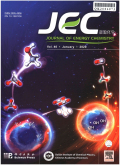- 钛学术文献服务平台 \
- 学术期刊 \
- 工业技术期刊 \
- 石油与天然气工业期刊 \
- 能源化学期刊 \
Metal-organic interface engineering for boosting the electroactivity of Pt nanodendrites for hydrogen production
Metal-organic interface engineering for boosting the electroactivity of Pt nanodendrites for hydrogen production
基本信息来源于合作网站,原文需代理用户跳转至来源网站获取
摘要:
Recently,the surface chemical functionalization and morphology control of precious metal nanostruc-tures have been recognized as two efficient strategies for improving their electroactivity and/or selectiv-ity.In this work,1,10-phenanthroline monohydrate(PM)functionalized Pt nanodendrites(Pt-NDs)on carbon cloth(CC)(denoted as PM@Pt-NDs/CC)and polyethylenimine(PEI)functionalized Pt-NDs on CC(denoted as PEI@Pt-NDs/CC)are successfully achieved by immersing Pt-NDs/CC into PM and PEI aque-ous solutions,respectively.PEI functionalization of Pt-NDs/CC improves its electroactivity for hydrogen evolution reaction(HER)due to local proton enrichment whereas PM functionalization of Pt-NDs/CC im-proves its electroactivity for formic acid oxidation reaction(FAOR)by facilitating dehydrogenation path-way.With such high activity,a two-electrode electrolyzer is assembled using PM@Pt-NDs/CC as the an-odic electrocatalyst and PEI@Pt-NDs/CC as the cathodic electrocatalyst for electrochemical reforming of formic acid,which only requires 0.45 V voltage to achieve the current density of 10 mA cm-1 for high-purity hydrogen production,much lower than conventional water electrolysis(1.59 V).The work presents an example of interfacial engineering enhancing electrocatalytic activity and indicates that electrochem-ical reforming of formic acid is an energy-saving electrochemical method for high-purity hydrogen production.

推荐文章
Effects of organic mineral fertiliser on heavy metal migration and potential carbon sink in soils in
Karst
Soil pollution
Cd
Organic mineral fertilisers
Carbon sink
The contribution of bacteria to organic matter in coal-measure source rocks
Coal-measure source rocks
Organic matter type
Bacteria
Monomethyl alkanes
Alkyl cyclohexane
CO2 emission and organic carbon burial in the Xinanjiang Reservoir
The Xinanjiang Reservoir
Carbon emission
Sediment
Carbon retention
Effect on greenhouse gas balance of converting rice paddies to vegetable production
Greenhouse gas balance
Land management change
CH4
N2O
Soil organic carbon
内容分析
关键词云
关键词热度
相关文献总数
(/次)
(/年)
引文网络
引文网络
二级参考文献 (0)
共引文献 (0)
参考文献 (0)
节点文献
引证文献 (0)
同被引文献 (0)
二级引证文献 (0)
2020(0)
- 参考文献(0)
- 二级参考文献(0)
- 引证文献(0)
- 二级引证文献(0)
引文网络交叉学科
相关学者/机构
期刊影响力
能源化学
主办单位:
中国科学院大连化学物理研究所
中国科学院成都有机化学研究所
出版周期:
双月刊
ISSN:
2095-4956
CN:
10-1287/O6
开本:
出版地:
大连市中山路457号
邮发代号:
创刊时间:
语种:
eng
出版文献量(篇)
2804
总下载数(次)
0
总被引数(次)
7996
期刊文献
相关文献
推荐文献
- 期刊分类
- 期刊(年)
- 期刊(期)
- 期刊推荐
一般工业技术
交通运输
军事科技
冶金工业
动力工程
化学工业
原子能技术
大学学报
建筑科学
无线电电子学与电信技术
机械与仪表工业
水利工程
环境科学与安全科学
电工技术
石油与天然气工业
矿业工程
自动化技术与计算机技术
航空航天
轻工业与手工业
金属学与金属工艺
能源化学2022
能源化学2021
能源化学2020
能源化学2019
能源化学2018
能源化学2017
能源化学2016
能源化学2015
能源化学2014
能源化学2013
能源化学2012
能源化学2011
能源化学2010
能源化学2009
能源化学2008
能源化学2007
能源化学2006
能源化学2005
能源化学2004
能源化学2003
能源化学2002
能源化学2001
能源化学2020年第9期
能源化学2020年第8期
能源化学2020年第7期
能源化学2020年第6期
能源化学2020年第5期
能源化学2020年第4期
能源化学2020年第3期
能源化学2020年第12期
能源化学2020年第11期
能源化学2020年第10期
能源化学2020年第1期

 免费查重
免费查重










